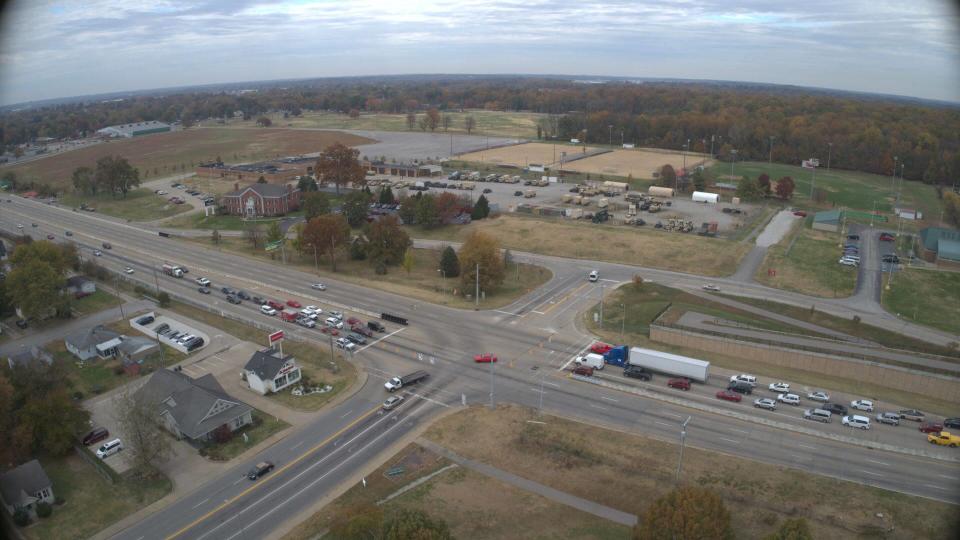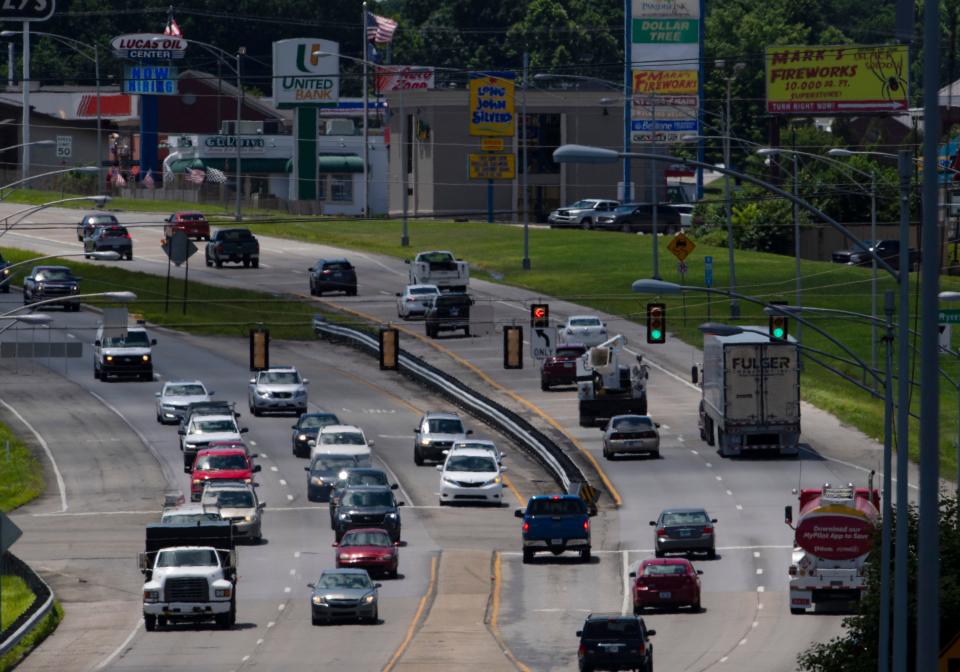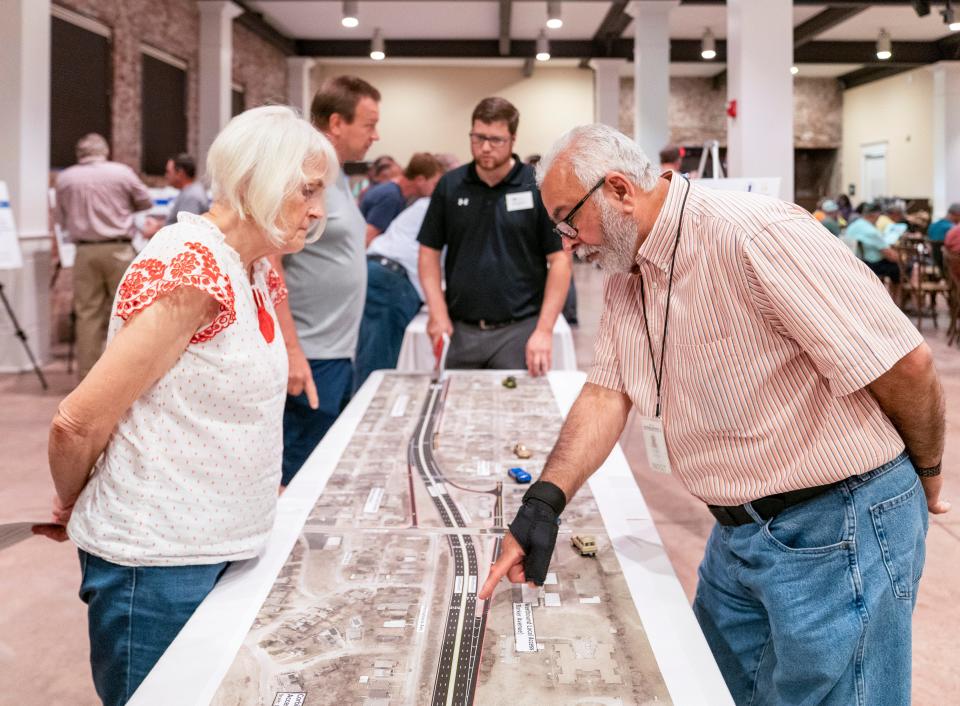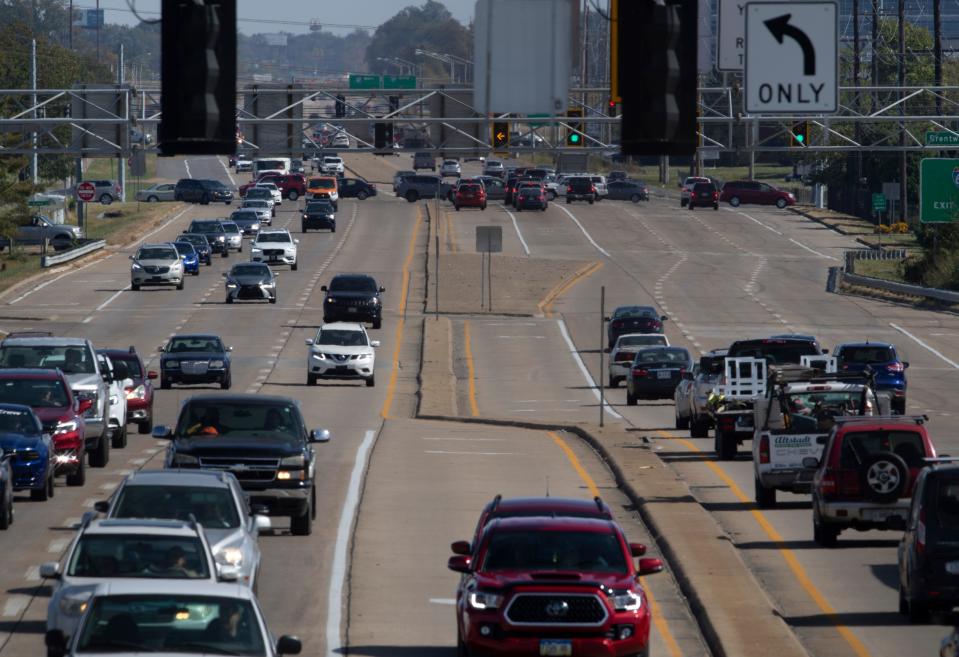'People should be prepared': Major overhaul of the Lloyd Expressway will start soon
EVANSVILLE – Major overhauls to the Lloyd Expressway that will cause traffic headaches for the next three to four years could begin as soon as around two months from now.
That’s according to Nicole Minton, public outreach manager for Lochmueller Group, the Evansville-based engineering firm behind the more than $100 million Indiana Department of Transportation project.
Between now and 2028, around 20 intersections will receive anything from minor work to thorough overhauls that will reshape the look and flow of Evansville’s main artery – and leave residents navigating miles of orange barrels.
First up will be Vann Avenue and Stockwell Road.
The former will lose its stoplights – a controversial plan that’s drawn ire at public meetings – and become right-turn only on its south and north sides. The latter, meanwhile, will receive a facelift that will render it an “alternative intersection” complete with a “displaced left turn” and a “boulevard left.”
Work on those will begin in late April or early May, Minton said. Not long after, a slew of West Side construction will launch as well.
Minton believes the work will make Lloyd safer and easier to drive – but she acknowledged it will also bring delays and complications for years to come.
“I think that people should be prepared for travelling at off-peak times, finding alternate routes (and) avoiding the Lloyd when they can,” she said.
“Growing is painful, and this one is going to have some growing pains to get through this.”
Here are some things to know as construction begins – including who will be the most affected, and one thing project officials are counting on to make this whole thing work.

What happens first?
Work will stretch from the Posey County line to the cusp of Newburgh and have staggered launches, meaning the whole expanse of the Lloyd will never be fully ripped up at the same time.
“Phase one” at the intersection of Vann and the Lloyd will begin with work on the westbound shoulder, widening it to accommodate construction, Minton said.
Crews will also replace cross drainpipes and slap up signs warning drivers of the impending changes to the intersection. Signs will eventually dot the entire road, Minton said, in an effort to keep drivers from “going blind” to changes on a commute they take every day.
Eventually a barrier will go up across the middle of the Vann / Lloyd intersection to block anyone from crossing the road. The lights will disappear as well, although officials couldn’t provide an exact time as to when that will happen. “Before 2025” was as specific as they got.
'Staggering': Vann called dangerous intersection
Matthew Bullock, a project manager with INDOT, provided the Courier & Press with data from a pair of three-year studies he said showed Vann to be a high-crash location – not only in amount, but severity.
In a recent three-year period, he said, there were 21 “fatal or incapacitating” crashes at Lloyd and Vann, with most coming in the eastbound Lloyd.
“These 21 crashes are only the most severe. 162 other crashes occurred at the intersection in the same time span,” he said.
INDOT uses multiple equations to assess an intersection’s safety. Index of Crash Frequency measures the difference between expected crashes at an intersection – compared to intersections of its kind across the state – and the number of actual, reported crashes.
A score of 2 or higher would render an intersection a “high crash location,” he said. In 2014-16, Vann scored a 2.76. In 2015-17, it was a 3.18.
Then there’s Index of Crash Cost, which measures the severity of each collision or accident. A score of 4, he said, would be “staggering.” And that’s just what Vann got – a 4.44 in ’14-16 and a 4.87 in ’15-17.
“An ICC of 4 means the crashes at the Vann and the Lloyd are more severe than 99% of all other locations based on the severity of the crashes,” he said.
Stockwell Road
Work on Stockwell will launch simultaneously.
Perhaps the biggest change will come in the eastbound lanes, where the current left turn will transform into a “displaced left” that will require drivers to get into left turn lanes before reaching the main intersection. They will then turn based on their own signals. Like many of the alternative solutions, it’s meant to improve traffic flow.
Left turns will also change for westbound drivers. The new “boulevard left” will require them to go past the intersection and make a U-turn, sending them back the opposite direction to turn right onto Stockwell.
One concern that’s come up in public comment has been whether drivers turning off the soon-to-be right-only at Vann Avenue would have enough time to dash across eastbound Lloyd traffic and reach the displaced left turn at Stockwell safely.
Minton said modeling done by project engineers show that drivers should have enough gaps in traffic to do so. That’s not the case in the current stretch between I-69 and the southbound left at Cross Pointe Boulevard, she said. That’s why workers will eventually install a stoplight off the westbound Lloyd exit.

The West Side
Work on several West Side intersections will also begin this year, likely in the summer.
Those projects weren’t initially supposed to start until 2025, but they were moved up to begin around the same time as the Vann and Stockwell work, Minton said.
“Minor interchange improvements” – as INDOT calls them – will take place at University Parkway, Rosenberger Avenue and Boehne Camp Road. At Rosenberger, for instance, the left turn lane onto the westbound Lloyd will be elongated.
Red Bank Road will see major overhauls, getting a displaced left turn like Stockwell. Other huge changes will come in the form of bridge replacements at Tekoppel Avenue, as well as at Carpenter Creek and the CSX Railroad. The pedestrian bridge near St. Joseph Avenue will also be replaced.
Projects at other West Side intersections, though, won’t launch until around 2026. Those include “minor” work at St. Joe and Wabash, and an “interchange modification” at Barker Avenue.

What about lane restrictions and the speed limit?
“There will always be one lane of traffic open in each direction,” Minton said. “In some cases, there will be two.”
Speed limits, meanwhile, will “typically” be 10 miles-per-hour below the normal speed limits posted now, Bullock said. But there’s the potential for further reductions depending on the phases of construction.
What everyone will have to be ‘embrace’: the zipper merge
There’s one important aspect everyone will have to embrace if we stand any chance of this running smoothly, Minton said.
Meet the zipper merge.
Instead of everyone queuing up in one lane as soon as the first whiff of a lane closure arises, the zipper merge requires drivers to stay in their respective lane for as long as possible to keep traffic humming. Then, at the last second, drivers from the dead-ending lane will take turns to merge one-by-one with drivers from the flowing lane.
But that requires kindness and patience: two things that might be lacking on a snarled, ripped-up Lloyd Expressway.
Minton worries that those who stay in the ending lane might be ostracized by drivers in the flowing lane, leading to backups and maybe even accidents.
“It’s really important that these folks (in the non-closing lane) are kind and let people in,” she said. “That they don’t think that these guys (in the other lane) are being jerks and say ‘no, no, no. You didn’t wait your turn.’ We have to fill both lanes.”
She said queueing up in one lane could cause cars to back up in the middle of intersections – especially in light-heavy clusters on the West Side.
She said INDOT is crafting signs explaining the zipper merge that will soon perch along the expressway. But even if it does work smoothly, merging could lead to headaches and delays, especially during peak hours.
Who will be the most affected?
“I think West-Siders have some limitations just because of the geography of the river and the railroad,” Minton said. “And there are some less reliable detours on the West Side.”
Those include alternative routes such as Ohio Street, which is sometimes sliced in half by a CSX train, and the Ray Becker Parkway, which can flood if heavy rains sweep through the area.
The East Side, meanwhile, is more of a grid, with multiple options for moving from one side of town to the other.
Alternate routes could fill up fast
Speaking of those other routes, Minton said drivers should expect Lloyd alternatives to fill up with more traffic than drivers are used to.
Lincoln and Diamond avenues could swell with vehicles, as could Walnut Street – once the lingering construction there finally ends this spring.
The changes at Vann could slow north-south movement as well. When portions of Weinbach Avenue closed last year, traffic flushed onto Boeke Road, causing long backups at peak hours.
The already-busy Green River Road may have to absorb more cars as well, as will the similarly packed Weinbach Avenue and U.S. 41.
When residents asked about those concerns during public meetings, officials often told them not to worry: the grid can support it.
That claim comes from traffic modeling, Bullock said. Project officials used INDOT traffic counts, as well as possible city growth rates compiled by the Evansville Metropolitan Planning Organization, to figure out how drivers may disperse once one of the main veins of movement is limited. They then plugged the data into various software to model how they think “intersections will perform.”
Those models will be put to the test once construction is in full swing.

Text and email alerts
At the Lloyd 4U website, residents can sign up for email alerts or text “INDOT LLOYD” to 468311 to receive updates on their phone.
Minton said those are key. It's important for drivers to know when traffic patterns change or when new projects get underway. That will help them traverse the Lloyd safely without any surprises.
What the more distant future looks like for the Lloyd Expressway
After Vann and Stockwell are done, work will then begin on Burkhardt Road and Cross Pointe Boulevard: two of the largest overhauls of the project.
Both will receive a pair of displaced left turns going each direction. Then there’s the new stoplight at Interstate 69, which will go in someone after the initial wave of work begins.
Burkhardt and Cross Pointe were slated to begin this year, but they likely won’t start until 2025. Construction will linger into 2026.
And that’s when the final projects – St. Joe, Wabash, Barker and Igleheart – will finally begin. As of now, the full slate of work isn’t expected to end until 2028.
“These are improvements I want my 16-year-old to drive on,” Minton said. “They’re safer.”
The forthcoming changes, however, will never achieve what some believe the expressway should be.
“I would love that, too – to not have to touch the brake between the West Side and the East Side,” she said. “But the way the Lloyd has been developed around, it would just cost so much to relocate people and to buy property.
“What is being planned is working very well in other places. … I know everyone is a skeptic whether or not this will really make changes,” she said. “But we’re asking people to do a little educating and just make sure they’re aware of how the intersections are going to work and that they’re aware of the changes that are coming. And let’s see how well this works.”
Contact Jon Webb at jon.webb@courierpress.com
This article originally appeared on Evansville Courier & Press: Lloyd Expressway work starts soon. Here's how it will change your life

